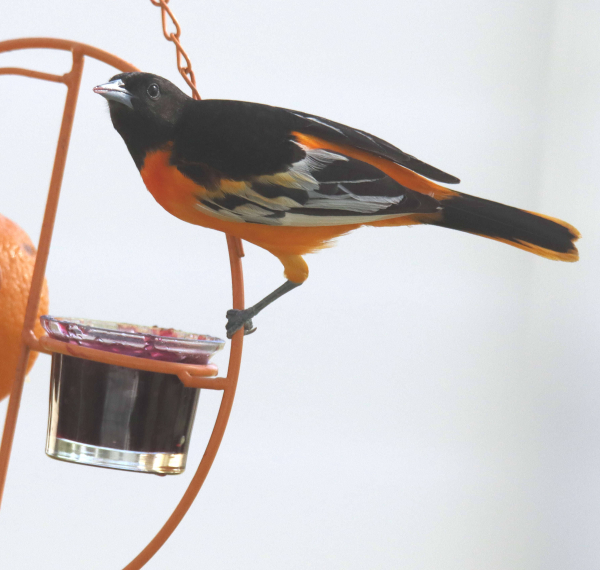
This male Baltimore Oriole has a distinctive yellow-orange colored plumage that provides insights into its behavior and the fact that it is the only male Baltimore Oriole to visit Paul’s feeding station recently (photos by Paul Konrad).

A partial-albino Baltimore Oriole provided the best example of an individually marked bird and showed that it spent time visiting Paul’s feeding season in 2022 and 2023. Keep an eye out for any identifying plumage to help you study the behavior of individual birds in your yard.
|
There are a lot of things you can learn about birds when you have a chance to recognize and observe individual birds that visit your feeding station and birdbath. Studying the behavior of individual birds can provide insights that take you to another level of enjoying birds. But too often, one male of a species looks like another, as do all the females – at least to humans. Every once in a while though, a bird comes around that shows some identifying characteristic, such as a male Baltimore Oriole that dropped by about 10 days ago that is colored yellow-orange rather than deep Baltimore orange.
It's always something of a breakthrough when you have a bird that you can re-identify each time it visits your feeding station, and you can not only learn more about that individual, but also extend it to the species within reason – and to the local birds of that species that visit your feeding station, yard, and neighborhood. For example, the yellow-orange male Baltimore Oriole has allowed me to ascertain that it is the only male Baltimore that is coming to my feeders now. If it was a regular orange male, I wouldn’t be able to tell if it was an individual or if 2 or more male Baltimores were visiting.
That’s the case with Orchard Orioles: I can’t tell if there is 1 male or 2, or more Orchards. And although I suspect there are more than 1, I can’t really verify that until more than male arrives at the same time, because I can’t tell 1 from another. That’s true for female Orchard Orioles too, but I’m almost positive there are at least 2 females, because 1 appears to have duller olive-colored dorsal plumage, and subdued yellow underside plumage. A second female has much brighter olive-colored dorsal feathers and very bright yellow ventral plumage. While the shades of color are less obvious than other identifying characteristics, it still works to tell which female is which – but are there more than 2?
When you really get lucky, you may get a bird with a different, more obvious identifying coloration, like the partial albino (leucistic) male Baltimore Oriole that visited my feeding station in August of 2022, after the nesting season. Then, seemingly miraculous return, it appeared at the same feeder at the same location in my yard the following spring in May of 2023, and he stayed through the nesting season to the beginning of August. That individual presumably migrating south to another nation or nations with Baltimore Orioles’ wintering range between central Mexico and central Colombia. That striking male was so uniquely colored that there could only be one; it had white feathers on its left wing – and it provided a singular pleasure to have it appear day to day and year to year during that period!
Later in the summer, when birds are molting, it’s possible to identify an individual as it molts different feathers, especially tail feathers, but watch for any feathers that help you identify an individual. Sometimes, young birds can also provide some individual variation when they have different shades of color or spotting, such as I see in fledgling American Robins in my yard now.
Of course, biologists have long been looking for ways to identify individual birds to learn more about each species’ behavior and movements, as well as individual variation and even aging. This was first accomplished by banding birds with numbered aluminum bands, then by color marking a second or third band. Today, satellite tracking has been paramount to learning a wealth of information about birds, especially the varied migration routes among populations and species as a whole. How exciting it has been to see this transition, possible through the miniaturization of transmitters and batteries, and by the increased availability of satellites and tracking stations.
But that level of monitoring isn’t available to we mere mortals, so the best thing we can do is to watch for identifying characteristics. And one of the best ways to do that is to use binoculars when you are home, to get a better, more detailed view of birds through windows, and when you are in outdoor spaces, perhaps a deck, balcony, or patio. Every birder has a pair of binoculars, and many people find that a second pair to use at home is an excellent option, rather than carrying your field binoculars back and forth from home to wherever you are headed on a given day.
Finding birds that you can identify individually definitely adds a lot to backyard birding experiences, and just looking for an identifying characteristic in a given bird is part of the fun – and we all need a little more fun in our lives too. Enjoy the birds around you and the time you can devote to birding – at home and beyond throughout the summer season.
Article and Photos by Paul Konrad
Share your backyard birding experiences and photographs with The Birding Wire at editorstbw2@gmail.com